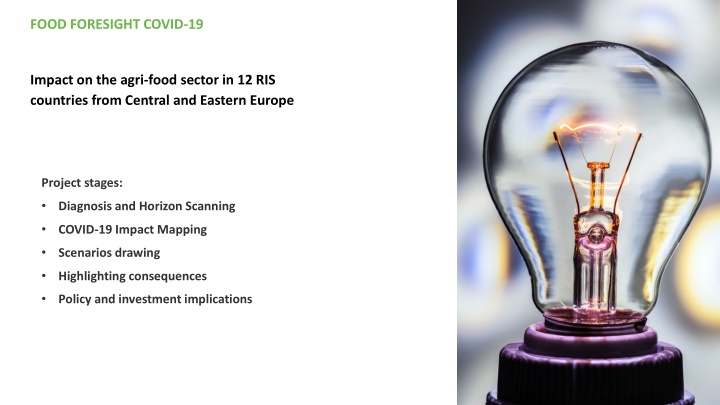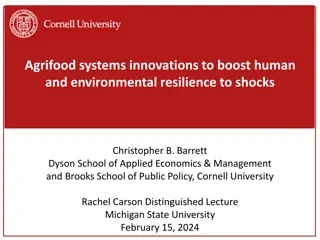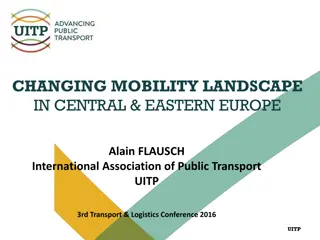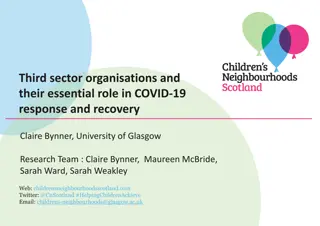Impact of COVID-19 on Central and Eastern Europe Agrifood Sector
This project explores the implications of COVID-19 on the agrifood sector in 12 RIS countries from Central and Eastern Europe. It covers key vulnerabilities, scenarios, and opportunities for sustainable recovery.
Download Presentation

Please find below an Image/Link to download the presentation.
The content on the website is provided AS IS for your information and personal use only. It may not be sold, licensed, or shared on other websites without obtaining consent from the author.If you encounter any issues during the download, it is possible that the publisher has removed the file from their server.
You are allowed to download the files provided on this website for personal or commercial use, subject to the condition that they are used lawfully. All files are the property of their respective owners.
The content on the website is provided AS IS for your information and personal use only. It may not be sold, licensed, or shared on other websites without obtaining consent from the author.
E N D
Presentation Transcript
FOOD FORESIGHT COVID-19 Impact on the agri-food sector in 12 RIS countries from Central and Eastern Europe Project stages: Diagnosis and Horizon Scanning COVID-19 Impact Mapping Scenarios drawing Highlighting consequences Policy and investment implications
Stituation of Slovenian Agrifood sector Agriculture, share in total Gross Value Added (%) Agriculture, share in total Gross Value Added (%) 9% Key macro vulnerabilities 8% 7% Ageing population 6% 5% Decelerating economic growth. 4% 3% Exposure to uncertainty at global level and decline in international trade. 2% 1% Faltering investment in machinery and equipment. 0% 2008 2009 2010 2011 2012 2013 2014 2015 2016 2017 Imports outpacing exports. Slovenia CEE Min CEE Median CEE Max
Four scenarios CONSUMERS BACK TO OLD WAYS OF CONSUMPTION and PURCHASING FULL RECOVERY PATHWAY NEW RULEBOOK PATHWAY ECONOMY RECOVERED WITH LIMITED CONTAINMENT MEASURES ECONOMY DECLINING WITH NEW CONTAINMENT MEASURES DISTORTION AND DISRUPTION PATHWAY NEW CONSUMER PATHWAY CONSUMERS LEARNING NEW HABITS
Key Opportunities for a Sustainable Recovery Key Opportunities for a Sustainable Recovery Farmers and input providers Opportunity Source Potential new consumer base More individuals seeking local products Innovations in the production process towards better resource efficiency and lower environmental impact Changing demand and social preferences requiring alterations to the production process More direct contact with consumers and higher margins Shortened distance between farmers and consumers as a result of changing consumer preferences Economies of scale through increased national and regional cooperation Disruption of larger international supply chains but continued investments in transport infrastructure in CEE
Key Opportunities for a Sustainable Recovery Key Opportunities for a Sustainable Recovery Food processing, storage, and transport Opportunity Source Opportunities for local suppliers to showcase their own products Growing consumer interest in local goods as well as products will lower environmental footprint Opportunity to green the food production process Changing demand requiring alterations to the production process New and effective transport and storage solutions Transport disruptions Need for higher self-sufficiency within the country or region Trade and supply chain disruptions
Key Opportunities for a Sustainable Recovery Key Opportunities for a Sustainable Recovery Retailers, restaurants, and consumers Opportunity Opportunity Source Source More informed consumer choices and new More informed consumer choices and new fields of competition fields of competition Growing tendency to prepare food at home and sustainability- awareness Higher interest in local food retailers and Higher interest in local food retailers and markets and resulting positive effect on margins markets and resulting positive effect on margins Growing consumer interest in local products Growing interest in specialized stores and Growing interest in specialized stores and resulting positive effect on margins resulting positive effect on margins More demanding consumers due to continued socio-economic development or health & dietary needs Digitalization Digitalization rise of online ordering and home rise of online ordering and home delivery of food delivery of food Necessity or desire to remain home
Follow the discussion! Official Launch of the report online: Agrifood sector in Southern and Eastern Europe: Future-proof or future-ready? (28th October) Session on the impact of COVID19 on the agrifood sector during Future of Food conference (1-2 December) Download the report! http://eitfood.eu/foodforesight























